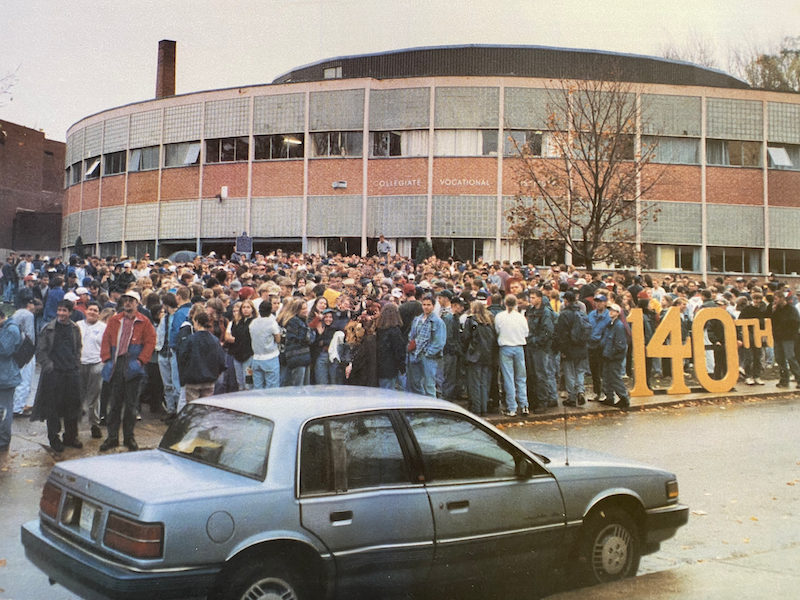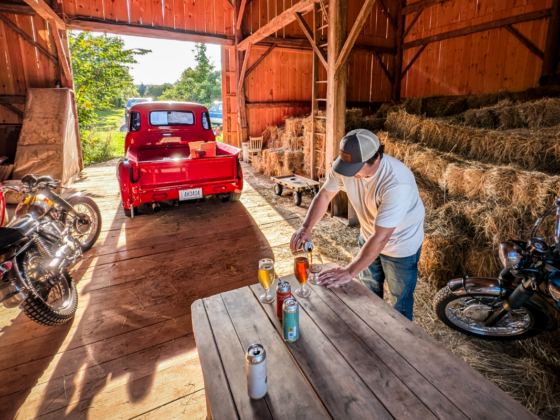Have you ever had a lucid dream? One where you realized you were dreaming?
I’ve only had one. I was standing outside my old high school with a friend, who I suddenly turned to and said: ‘Do, you realize our high school was torn down years ago?’ and pointed to the one before us. ‘This means we must be dreaming!’ He looked at me and asked what we should do. And in our idiot brains, with all infinite possibilities of taking control of a dream, we decided it was best to go ask out the girls we were too afraid to ask out in high school. We ran up the 9th Street walkway of the old OSCVI, into the ringed corridor and started looking for our high school crushes. But the school was empty and all we did was run around in circles, literally.
The hallways of my old high school were built as a two-storied circular structure with classrooms around the circumference, and a gym and an auditorium in the middle. Anyone who went to the school knows exactly what I mean. Anyone who doesn’t just needs look at the photos to understand.
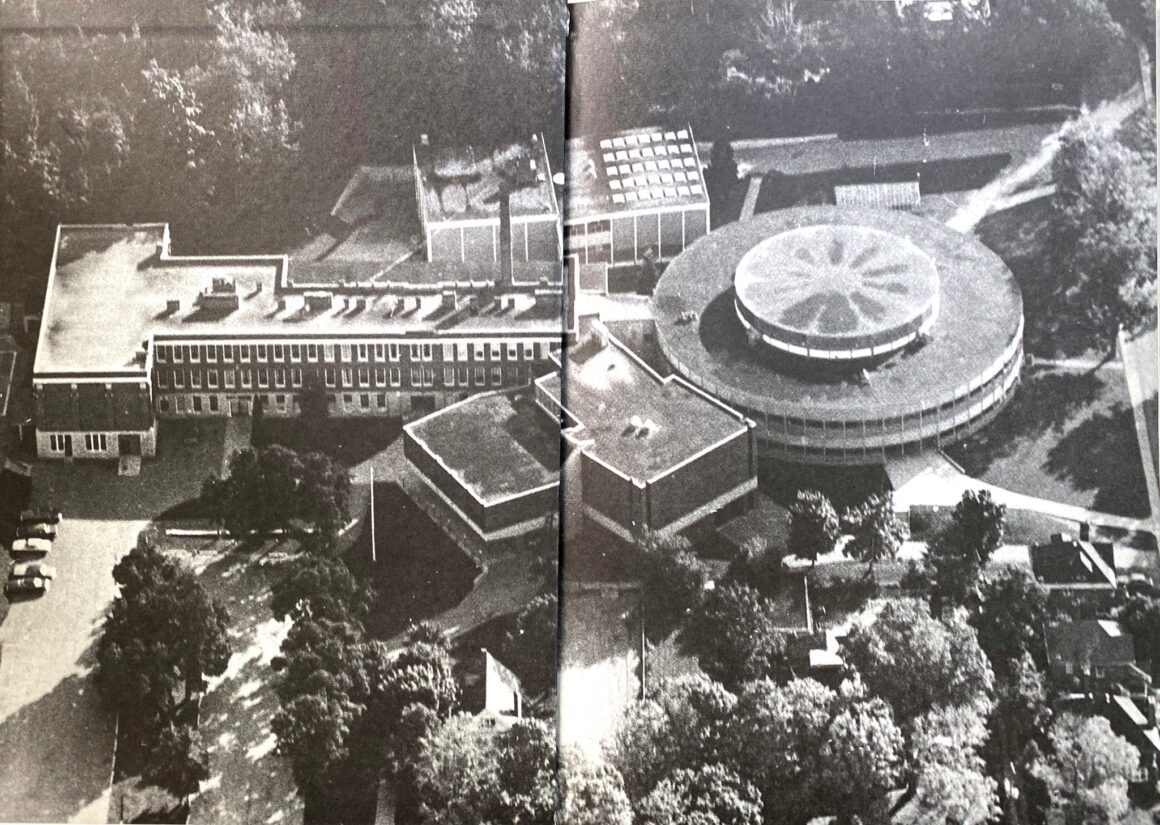
I dream about my old high school a lot. I guess that’s normal – the old ‘naked in the cafeteria’ or ‘not prepared for a test’ standards. High school is/was a pivotal time for everyone. But I like to think that OSCVI shows up in my dreams a lot because it was such a unique building, and unlike any other I occupy as an adult.
I guess what I’m saying is, they don’t build schools like that anymore. Hell, they don’t build anything like that anymore. And I think that’s a damn shame.
I still remember my first day at OSCVI like it was yesterday. The ultimate blend of nervousness and excitement. I wore the coolest pair of baggy jeans I had, and my Bones Brigade t-shirt. It was a warm September morning as I walked up the grand steps with the only friend from grade 8 who was attending the OSCVI with me. We’d both made the bold move from the Catholic Middle School, St Basils, to the public high school. I can’t say why exactly I didn’t want to go to St Mary’s – I like to think it was my early agnostic leanings, but it was likely that I only lived a literal two minute walk from OS, which allowed me to sleep in to 8:45 every morning and be in first period English by 8:59 just as the morning announcements were being cued up by the Head Boy and Head Girl over the intercom.
But I know in large part, my decision to go to OSCVI was due to the commanding presence it had at the bottom of the East Hill in Owen Sound, a building like no other I’d ever seen, with giant circles connected by tentacles of historied hallways, surrounded by basketball courts, tennis courts, and a massive parking lot for all the older teens who could drive. It was a marvel of glass, steel, concrete and brick.
It was commanding; it required respect. Sure, the other two high schools at the time served their purpose, but they were largely one-story and full of right angles. Respectable, but not unique.
You’ll never see another high school like it again. They just don’t make them that way anymore. The schools they seem to build now are much more economical, practical and boring as hell, in my opinion.
OSCVI had three gyms. Three. There was also an auditorium with grandstand seating. And a separate large cafeteria. They didn’t combine them together as they do now. There were auto shops, drafting rooms, a greenhouse, theatre arts rooms, music rooms and a library (duh). But get this: the library was cantilevered over the front of the property. Cool right? I always wondered if it would ever just suddenly break off and fall.

There were ramps connecting each ringed corridor with the main hallways. Stairways at every turn. The business wing off the top hallway somehow connected to the library by a stairwell. The office and student services were in some nether-region off the main hall that mysteriously connected back to the ringed corridor. Where the heck did the space for the theatre arts room come from? The North Gym somehow led out to the basketball courts by a hidden stairwell only a teacher could access. There was a tunnel under 10th Street hill that took you to the baseball diamond and Victoria Park. There were openings in the floor of the South Gym that led you between the walls around the circular hallways to eavesdrop on your friends. Whose idea was it build the East addition for the music rooms with a glass hallway?
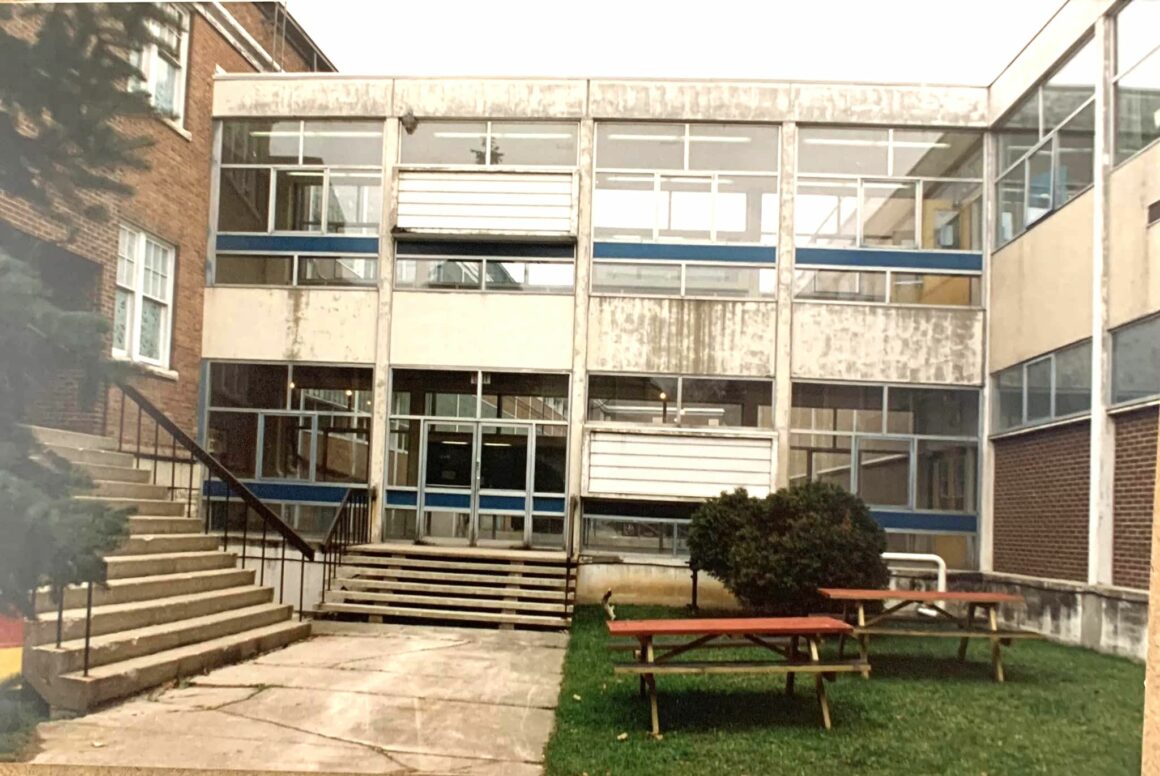
One thing I realize now is that this old school was built for student engagement. It was built with the purpose of students being together and forming community. The South Gym had stands that encouraged us to watch basketball games together after school, the auditorium grandstand seating encouraged us to attend school functions, even just an assembly, which were usually fun as hell and centred around the House System, where students were sectioned into one of four houses (Gamma, Delta, Sigma and Beta) and competed for points each year. The massive score board above the upper ramp kept the score.
Games like Gotcha connected the student body together. I still remember my friends getting hypnotized in the auditorium, watching school productions of the Mousetrap, going to Friday night dances, and Battle of the Bands. Helping the minor-niners adjust with the Gnomes program was a great idea and I remember even being held on weekends.

The hallways were wide, encouraging us to hang out before and after class. and the rooms were all spacious. It’s a place that encouraged us to spend time during the week and even on weekends for fundraising events in the gym, or tournaments, or putting the yearbook together.
So, why don’t they still make those kinds of schools anymore?
Well, I’m not an architect. I have no qualified opinion; I imagine it comes down to cost. But you know who is an architect? Kaegan Walsh, a friend of Rrampt and someone we’ve featured previously.
I thought I’d ask Kaegan what made the old OSCVI stand out. For context, the school was established in 1856 and built fully by 1880. It took the name Owen Sound Collegiate and Vocational Institute in 1924 when the new vocational wing was built. A fire took the majority of the older part of the building in 1952, so it required a rebuild on the existing site with a further addition completed in 1970.
“Overall, modernist architecture in the 1960s, and subsequently OSCVI, sought to create educational environments that were innovative, functional, and reflective of a forward-thinking society,” says Kaegan. “While it is arguable that modernist architecture achieved these goals, schools were designed to inspire and facilitate new ways of teaching and learning, embodying the optimism and dynamism of the era. The overall architectural aesthetic of OSCVI was a blend of historic and modern elements, reflecting its long history and the various phases of expansion and renovation. This blend gave the school a unique character, combining traditional educational architecture with more contemporary design features,” says Walsh.




Ah, yes, a unique character…that is what I think resonated with me the most. Its unique architecture established character with many nooks and crannies, hidden corners, and pathways that seemed to go nowhere. OSCVI alumni and Rrampt contributor, John Fearnall, remembers some of these unique characteristics:
“There was a strange catacomb-like structure in the basement, although students weren’t allowed to leave the main hall,” says John. “It led under the East wing and contained the boiler, and a huge book room that must have held many of the books from when the school first opened to when it closed. Many of our Ontario Student Records were also stored there. It was creepy as hell. And very musty.”
Fearnall says that spaces like that, along with other unique features like the glass hallway, the “cage” at the bottom of the ramp from the auditorium (once a student room where students were allowed to smoke) all allowed for some interesting videos to filmed in the early days of his media course.
Kaegan Walsh explains that “modernist architecture for schools in the 1960s was marked by a departure from traditional designs, embracing principles of simplicity, functionality, and an experimental spirit.”
Yes, that experimental spirit is what I’m talking about! What’s wrong with a little experimentation…isn’t that what high school is all about anyways? Isn’t there something about form equalling function in design? An experimental building for kids going through experimental times?

NYU professor Scott Galloway in his recent TED Talk on the youth says his parents worried he was going to experiment too much as a youngster, while he worries his kids aren’t going to experiment enough. Do we want our teens to experiment, take risks, make mistakes and problem solve? If so, let’s not build them boring schools. Just my two cents.
The experimental architecture of OSCVI reflects that. It sure seems like the architects made mistakes along the way themselves, as some parts of the building don’t seem to make perfect sense, but that’s what gave it its character: its flaws and mistakes. That’s where ingenuity happens. I mean did it make sense to have the busiest street in town separate the school from its sports fields? No, probably not, but a tunnel was built underneath the road to allow for safe passage. That brought character…along with a place for kids to surreptitiously smoke and get in fights, mind you. Not great things, but I smoked the odd cigarette in high school and got in a few fights; did I turn out alright? A question for my wife, I guess.
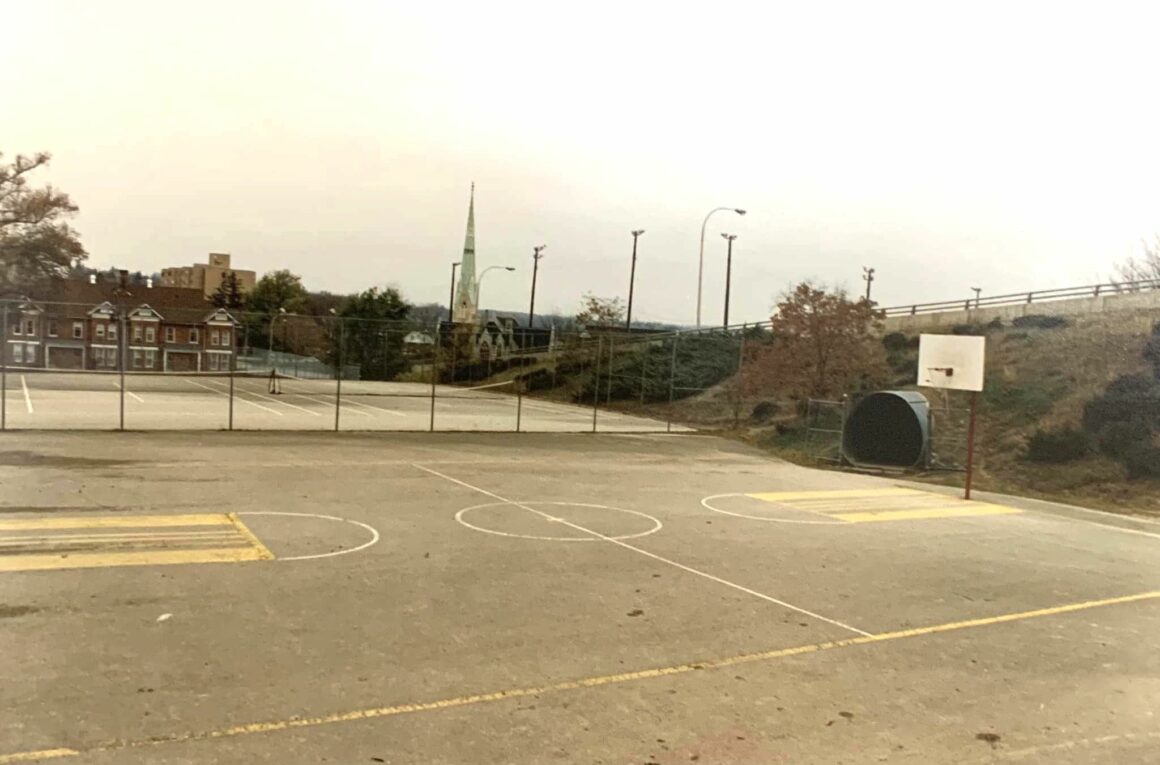
Fearnall notes another mistake in the school’s design: “if the auditorium was booked, no games could be played in the South Gym as the noise of balls bouncing, etc. would interrupt the performance.”
But I think there is something to this form equalling function kind of thing. If you don’t show young adults it’s good to experiment, what message are we sending them? In my opinion, I think we bubble wrap the youth too much and create far too many safe spaces for them instead of letting them make mistakes, take risks, and learn lessons.
Kaegan says that OSCVI’s architectural style “was characterized by its clean lines, geometric forms, and a minimalist approach that rejected unnecessary ornamentation. The goal was to create spaces that were not only aesthetically pleasing but also highly functional and conducive to new educational methods.”
Aesthetically pleasing…yes, what a concept. Why has functionality won out over aesthetics? Does it just come down to money, or is there a war on aesthetics in learning environments? No wonder the forest schools are becoming so popular – what better aesthetics than what mother nature provides.
“Key features of 1960s OSCVI school included the extensive use of materials such as concrete, steel, and glass,” adds Walsh. These materials were likely chosen for their durability, ease of maintenance, and modern aesthetic. Concrete was often left exposed, contributing to the raw, unadorned look that was a hallmark of the style. Steel provided the structural support needed for innovative designs (cantilevers, etc.), while large expanses of glass and glass block allowed for abundant natural light and diffuse light, creating bright and airy interiors. The brick was likely chosen to connect the new building to the older schools that came before it.”
It’s all starting to make sense now – the glass hallway, the cantilevered library at the front, the exposed brick.

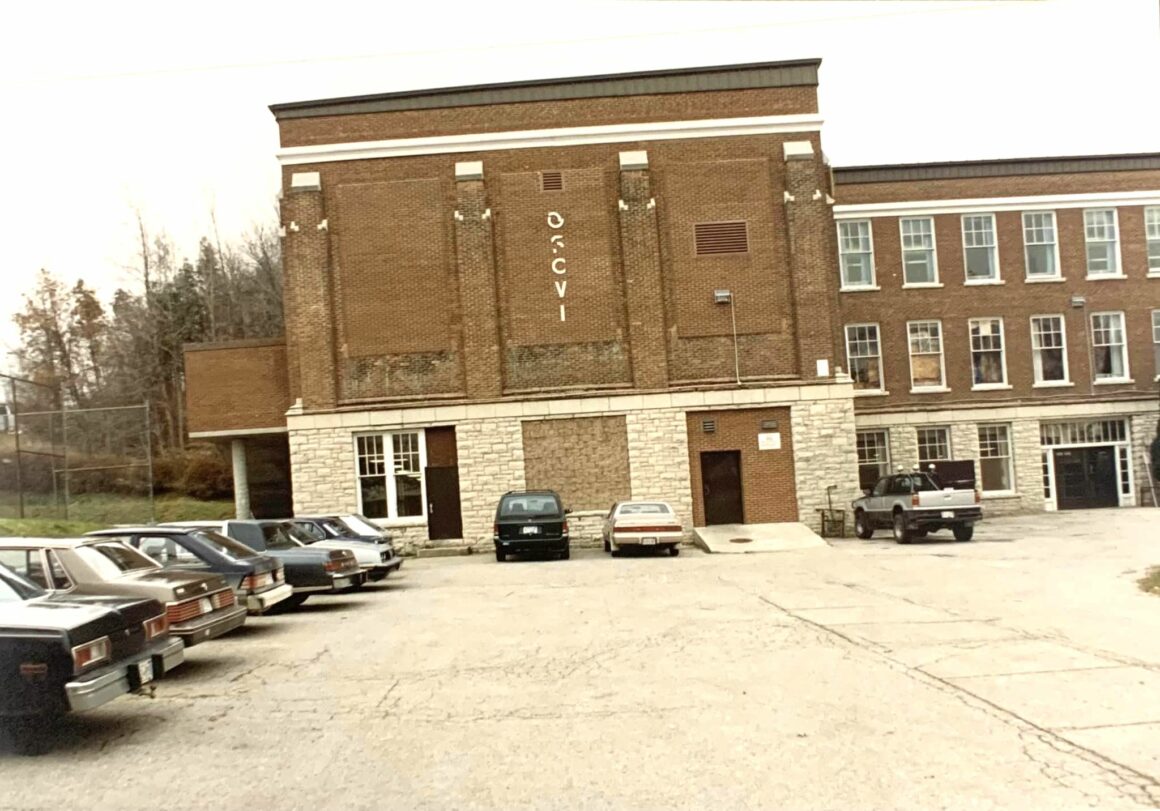
This is all what made Canada’s oldest high school so memorable; or at least it was the oldest school up until it was torn down in 1999 and sadly moved away from the downtown core. No longer could kids walk downtown to get a pizza slice for lunch or walk across town to see the rival football game on a Friday afternoon. No, sadly the new school was out on the outskirts of town, relegated to the land of farmer’s fields and the regional hospital.
When we all heard the news the old OSCVI was being torn down, it was pretty devastating. I was one of the last years to graduate from iconic school, but my sights were set on other parts of the world, so it didn’t hit me as hard. But after coming home from years away and time abroad, I realized how much I missed that old school. It was an empty field for awhile and then suddenly it was a neighbourhood. I guess the houses across the street all went up in value, one upside at least.
In the transition, generations of East Siders lost a piece of their youth. Teachers, admin and custodians lost their place of work. The town lost a piece of its history. And I lost the place where I grew from a pipsqueak into a slightly taller pipsqueak.
We felt bad for the following grades who wouldn’t be able to experience the magical place we inhabited. And it was sad to see how bland the new build was, up on the hill where busses would stream in and out.
Could anyone walk home for lunch? Where would they go when they skipped class? Could anyone sleep in until 8:45 and be there on time?
Years later, I still walk by the old OSCVI and have become used to the new subdivision that exists there, but the feeling of nostalgia is still strong, especially for my old hangout along 9th Street.
Even Kaegan recalls some personal history from that place: “On a personal note,” he says, “I recall playing a few basketball tournaments at OSCVI and loved the gym. Also, a close family friend of mine, who is an Owen Sound native, reminded me of the Battle of the Band concerts that were held there, and how she would get lost in the ring corridor when looking for the bathroom.”

Yes, sadly, like many other pivotal places from my youth, it no longer exists, and there in its place is a seniors community where one day I might live myself. Wouldn’t that be full circle? My front yard stretching to 9th Street where I once skipped class to hackey-sack and smoke darts, where we sat on the curb and talked about the weekend until someone rolled up and said they were making a Mickey D’s run and to jump in. Now, it’s Uber Eats that rolls up and delivers take-out to the houses there. Yes, times have changed.
I still keep a brick from the 9th Street entrance in my basement, and a sign for Student Services hung on my walls for years. There may not be another school built like that again. It was a moment in time that was pretty cool to be a part of.
If I have another lucid dream where I’m standing outside my high school again wondering what I should do, I’ll consider all the possibilities of flying around the world to cool places or meeting with famous people, but I’d be perfectly happy with just going into the old OSCVI again and walking the old hallowed halls of that special place, maybe pop in to see some old teachers – see if Boley’s got the obstacle course set up in the North Gym like he used to, stop in to say hi to Wallace and recite my Quadratic Equation to earn my candy bar, or sit in on Mr Taylor’s World History class and have my mind blown with this fascinating theories.
But I’d really like to spend a few more minutes at my old hangout on 9th Street with some old friends, talking about nothing important at all, and getting excited for the weekend party at Spencer’s lot. Because when I think about high school, the building was definitely a pivotal part of those years, architecturally unique for sure, but when it comes down to it, the old adage is right, as all old adages tend to be: it’s not about the places, it’s about the people.
For all the OSCVI alumni who miss their old school, let’s stand and sing to the OSCVI one more time.
Written by Jesse Wilkinson
Photos supplied by Nick Craig and John Fearnall

